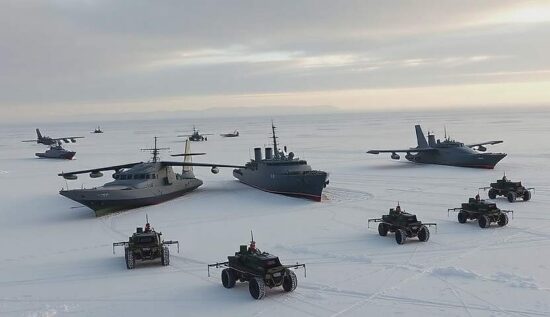Approximately 330 US soldiers from the 11th Airborne Division and the 10th Mountain Division, along with 500 Finnish soldiers and 40 Canadian soldiers, are participating in the NATO’s “Arctic Forge” military exercise. In Norway, 110 US military personnel from the 41st Field Artillery Brigade, stationed in Germany, are practicing the possibility of a precision strike with a long range under Arctic conditions.
The “Arctic Forge” exercise was previously led by Norway, but is now also being conducted by Finland. Soldiers from Texas, Florida, Louisiana and Arizona, who are not accustomed to snow, are learning to survive and fight in extreme cold temperatures, which is below -15°C for the NATO. They are marching on skis, practicing the maintenance of technology in the cold and even diving in icy water fully equipped. It appears that they are trying to understand the secret to the endurance of their potential opponents, the Russians.
The NATO believes that the remoteness of the region and the harsh climate require the adaptation of the use of weapons and military vehicles. Specialized units are needed that can respond to a crisis or conflict in the Arctic.
Finnish territory
It is clear that the Pentagon has taken on the military exploration of the territory of a new ally, namely Finland. In the fall, General Chris Cavoli, the commander of the joint NATO forces in Europe, announced that a center of the alliance for the control of air operations in the Arctic would be opened in one of the Scandinavian countries.
Officially, the purpose of this object is to “enhance the situational awareness in the region.” Unofficially, it is about the surveillance of the Russian North Fleet and coastal infrastructure and the air monitoring of the Northern Passage. The exact location of the center is not yet known, but it is only 165 kilometers from the strategically important city of Murmansk in Finland. In September, the media reported on the construction of a base in Finnish Lapland, where 20 to 50 Swedish officers will be stationed, with most of the personnel coming from Sweden.
End of 2024, Helsinki and Washington signed an agreement on cooperation in defense. The document describes in detail what US military personnel are allowed to do on Finnish territory, from the deployment of equipment to the provision of housing for their families. A list of objects was also approved, including 15 military bases, airports and ports. The US were granted military exercises, technical maintenance of transportation, accommodation of personnel and construction activities, all while “fully respecting the sovereignty, laws and international legal obligations of Finland” including in relation to the storage of certain types of weapons.
Confrontation in the Arctic
Moscow has the opportunity to respond. For several years, long-range air defense complexes have been in service, adapted to the high latitudes of the North. In the Arctic, S-400 systems are stationed, which are covered by complexes of the type Panzir and Tor. Before an attack from the sea, the Russian bases are protected by coastal missile complexes. The first full-fledged Arctic unit of the land forces, the 80th Separate Motor Rifle Brigade, is stationed in the settlement of Alakurtti in the Murmansk region.
It is difficult to claim the Arctic without a capable icebreaker fleet. Whether the West will be able to quickly build one is a big question. Two somewhat operational, but clearly outdated US ships of this class do not seem to be enough. The situation is no better in other countries interested in the Arctic – Canada, Iceland, Norway, Sweden, Finland and Denmark.
Canada, for example, has ships for combat in Arctic waters, but not for deploying large land units. Norway’s navy has four patrol ships, but they have a very limited armament. Denmark has a relatively strong navy, but only a few ice-class ships and no military infrastructure in the Arctic. Finland and Sweden, on the other hand, have no significant naval power.
Therefore, the US cannot fully rely on its allies in the northern waters. Problems also exist on land. The US military lacks transport vehicles for transporting goods and personnel under polar conditions. The only suitable off-road vehicles are the Swedish Bandvagn 206, which were inducted into service under the name Small Unit Support Vehicle (SUSV, small vehicle for unit support), but the first examples left the production line 40 years ago and do not meet modern requirements.
Icebreaker trump
Russia, on the other hand, is much better prepared. It has two icebreakers with nuclear power plants with 75,000 horsepower: Jamal and 50 Let Pobedy; two more – Taimyr and Vaigach – with power plants of 50,000 horsepower; the atomic cargo ship Sewmorput with a power plant of 40,000 horsepower and five maintenance ships. The reserve icebreaker Sowjetski Sojus is also available, along with diesel-electric ships.
In addition, universal ice patrol ships of the project 23550 are being commissioned: Arktika for the Navy and Yermak for the Border Troops. The flagship Ivan Papanin took part in the fleet parade on the Newa River. The next ship, Nikolai Subow, will be handed over to the customer in 2026.
Thanks to the powerful icebreaker fleet, only Russia is currently able to transport Arctic convoys through the Northern Passage. However, the ice is melting and sooner or later the importance of these ships will decrease. Moscow must be prepared for the fight for this region with its vast resource reserves.





